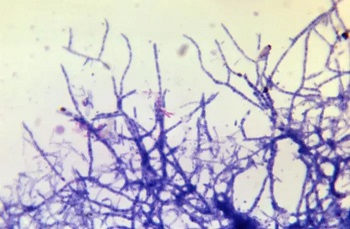Nocardia - Classification, Characters, Morphology, Culture, Etiological agents
Classification of Nocardia
Nocardia can be classified as follows:
Domain: Bacteria
Phylum: Actinomycetota
Class: Actinomycetia
Order: Mycobacteriales
Family: Nocardiaceae
Genus: Nocardia
Characteristics of Nocardia
Nocardiosis is an infection of the lung, brain, or skin by Nocardia spp. It is a localized or disseminated infection caused by aerobic actinomycetes Nocardia. It primarily affects immunocompromised patients.
It has 15 species among which Nocardia brasiliensis and Nocardia asteroides most common. They also cause bovine mastitis in cattle and nocardiosis in horses. Edmund Nocard first described the pulmonary and cutaneous disease in cattle.

Fig: Nocardia spp. (Source: Wikipedia)
Morphology of Nocardia
Nocardia spp. is gram-positive bacilli, branching, beaded, and filamentous hyphae. Morphologically, they are poorly gram-positive, acid-fast (also poorly), and obligate aerobes.
Culture of Nocardia
Nocardia can be grown on NA, SDA, BHI, YEME in the presence of 5-10% CO2, which facilitates its growth.
The incubation may take from 7 days to 3 weeks at 35-37°C. The colonies produce dry to waxy to white to orange colonies. Buffered charcoal yeast extract (BCYE) agar is a selective medium for Nocardia spp.
Test | N. asteroide complex | N. brasiliensis |
|---|---|---|
Gelatin | Negative | Positive |
Casein | Negative | Positive |
Tyrosine | Negative | Positive |
Urea | Positive | Positive |
Glucose | Positive | Positive |
Etiology of Nocardia
Nocardia asteroide complex consists of the following species:
Nocardia asteroides sensustricto
Nocardia farcinia
Nocardia nova